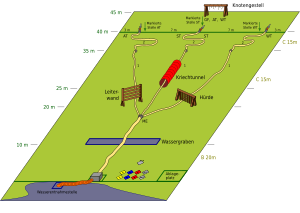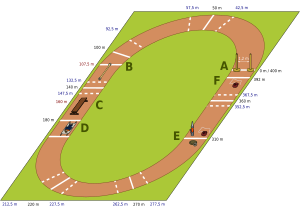Federal competition of the German youth fire brigade
The Federal Competition (BWB) of the German Youth Fire Brigade (JF) is a competition that is held every two years at the federal, state and district level and annually at the district and, if applicable, community level. It is the most important competition of the German Youth Fire Brigade . The participating youth fire brigade groups must first take part in community or district competitions and can qualify there for the next higher level.
Overview
This youth fire brigade competition consists of an extinguishing exercise according to fire brigade regulation 3 , as well as a 400-meter relay race. Each team consists of a fire fighting group (nine youth fire members) and a substitute. The substitute may be used if a member of the group falls ill, injures himself in the competition or is absent for other important reasons.
In Hesse, the national competition has also been offered for relay teams since June 2013 due to the low birth rate . There is no federal decision for this because the relay competition is only offered in Hesse.
The clothing must correspond to the personal protective equipment of the youth fire brigade .
Attendees
The participants in this competition must have reached the age of ten on the day of acceptance. If a youth firefighter reaches the age of 18, he may participate for the last time this year. The average age is calculated based on the year of birth and not based on the actual age on the day of the competition. This average age is necessary for the target time calculation of the relay run (B-part).
The A part
At the A section, the youth firefighters are supposed to carry out an extinguishing attack with three nozzles as a dry run. At the water intake point , there is a change between open water and underground hydrant every two years . Depending on which water extraction point is to be used during a competition, the time limit that the youth fire brigade teams must adhere to changes from six minutes (hydrant) to seven minutes (water). If the group is faster, it will not gain any points. However, if it is slower, one point is deducted for every second. Each group starts with 1000 points, from which the corresponding number of points would then be deducted. In addition, points may be deducted if the group makes mistakes while performing the competition exercise. Finally, part of the A section includes an exercise that involves tying four knots and stitches correctly as quickly as possible. One point is also deducted for every second that the group needs.
The B part
In the B part, the group has to complete a 400 m relay race with a few obstacles. Since, in contrast to Part A, the aim here is to complete the exercise as quickly as possible, this is often the decisive part of the competition. The first runners each have to run a certain distance, there is no obstacle in their path. The third runner simply has to roll up a 15 m long C-pressure hose on his way . The 4th runner must run over a bar. The 5th runner lies on a stretcher from the start , next to the stretcher lie his gloves, his helmet and a belt. When the 4th runner has passed the baton, the 5th runner has to put on the mentioned things as quickly as possible and move on to runner 6. This just has to run. The runners 7 and 8 must jointly couple a C-jet pipe with a C-pressure hose and tie a double anchor stitch with a half-throw to the jet pipe . Runner 9 must throw a firefighter linen bag and run through the finish line.
The group receives 400 points in the evaluation of the B part: If the group exceeds the individual target time, which is determined depending on the average age of the group, one point is deducted for every second of excess. In contrast to the A-part, if the target time is not reached, a point is added to the default number of points for every second. Error points may be deducted from this number of points.
impression
The judges give the marks 1, 3 or 5 for the overall impression of the different groups during both parts. The average of the grades (from A and B parts) is deducted from the total number of points.
Placement and prices
The points achieved in both parts are added and the number of points for the overall impression is subtracted. This gives the overall result. If two groups achieve the same number of points, the number of faults from the A section decides. Trophies, which are often donated by companies or politicians, are usually awarded as prizes.
Judges
Both parts of the competition by specially trained judges evaluated. At least five judges (A - E) are required for a competition if the A and B parts take place one after the other. One judge each is required for group leader and reporter (A), machinist (B), attack force (C), water force (D) and hose force (E). The evaluation of the group leader and the reporter is mostly reserved for the railway manager. Judge A acts as the first timekeeper of the total time, B as the second timekeeper. Judges C and D take the node timing. Errors are evaluated on the basis of score sheets. A certain number of failure points is assigned to each defect. In the B-part the existing judges of the track are divided accordingly, so that some two runners have to judge.
See also
Web links
- Competition regulations (PDF file; 530 kB)
- Evaluation sheet (open waters) (PDF file; 245 kB)
- Evaluation sheet (underground hydrant) (PDF file; 244 kB)
Individual evidence
- ↑ www.jf-hessen.de accessed on Aug 28, 2019

